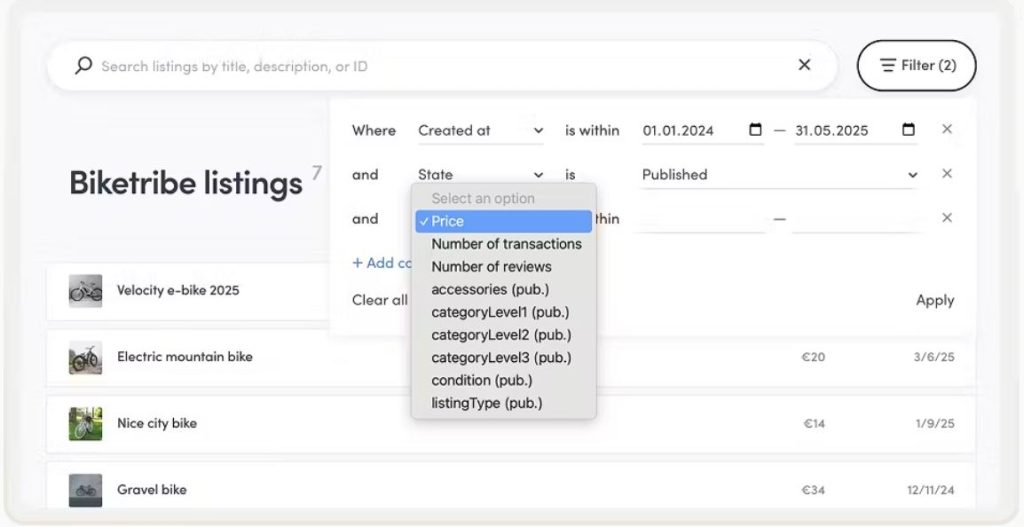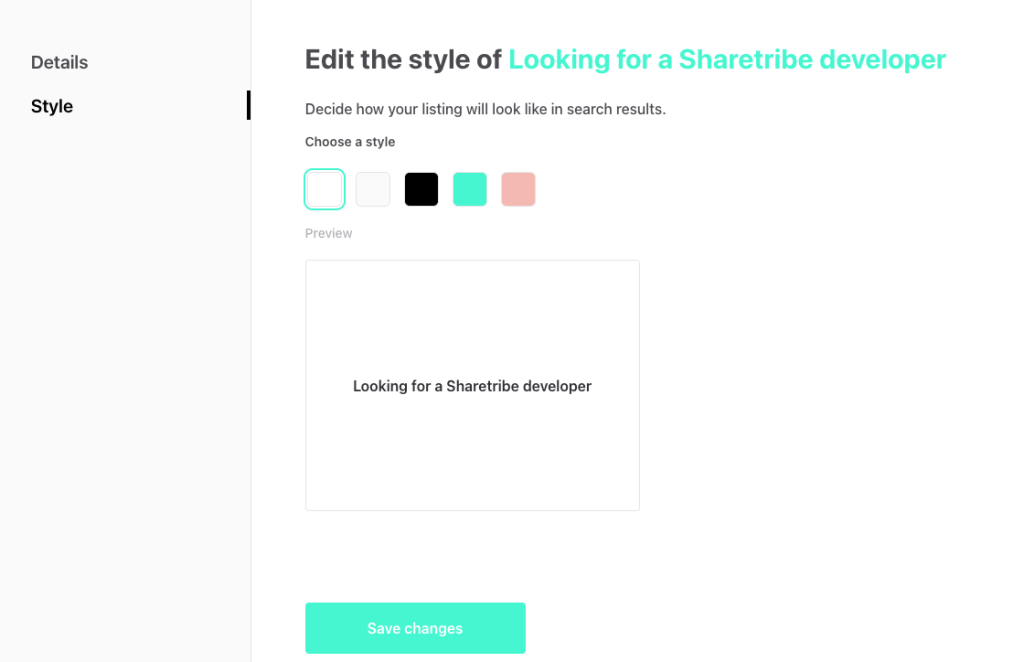Introduction
Running a successful online marketplace involves juggling multiple priorities—keeping listings organized, ensuring smooth transactions, and delivering an exceptional experience for both buyers and sellers. The challenge grows as your platform scales, with more users, listings, and transactions to manage every day. To help operators stay on top of these complexities, Sharetribe has introduced two powerful new features: custom filters in Console and the option to create listings without images.
Custom filters give operators granular control over data, allowing them to quickly locate listings, users, or transactions based on unique attributes or custom fields. At the same time, the ability to create listings without images streamlines the listing process, making it easier to manage service-based, text-driven, or professional marketplaces where visuals are not essential.
Together, these features not only save time and reduce administrative overhead but also open opportunities for new types of marketplaces that were previously difficult to manage efficiently. From reverse marketplaces and freelance platforms to classified ad sites and B2B services, these updates make it simpler than ever to create, organize, and grow a marketplace that meets the needs of both operators and users. In this article, we’ll dive deeper into how these features work, when to use them, and the benefits they bring to modern marketplaces.
Add Custom Filters to Console
Efficiently managing a marketplace requires the ability to quickly find and monitor listings, users, and transactions. Until now, operators were limited to default filters in Sharetribe’s Console, which made locating specific data or monitoring performance time-consuming. With custom filters, operators now gain unparalleled control over marketplace data, streamlining workflows and improving overall efficiency.
How It Works
Custom filters in Console are powered by Sharetribe’s flexible data model. Once a search schema is created—either via the no-code interface or the CLI/API—it automatically becomes available in Console. Operators can then apply these filters across listings, users, or transactions with ease.
There are two main ways to add custom filters:
1. No-Code Option
For operators who prefer simplicity, custom filters can be enabled directly in the listing field settings. Any field marked as a search filter automatically appears in Console.
-
Example: On a real estate marketplace, operators can mark fields like “number of bedrooms”, “pet-friendly”, or “furnished” as filters. When a property manager wants to find all listings that allow pets and have two bedrooms, it can be done instantly without writing a single line of code.
-
Benefit: This method is quick, intuitive, and accessible to non-technical team members, making it ideal for smaller teams or marketplaces just getting started.

2. API or CLI Option
For more advanced setups, Sharetribe’s APIs and CLI allow operators to create custom filters for complex data types and larger-scale operations. This includes public, private, protected, and metadata fields, enabling precise segmentation and management of data.
Types of extended data:
pub. = public data visible to all users
priv. = private data restricted to admins or operators
prot. = protected data shared selectively based on permissions
meta = metadata associated with listings or transactions
Example: On Biketribe, a bike rental marketplace, an operator can filter listings by frame size, bike type, or rental availability. In a freelance marketplace, transactions can be filtered by project type, client ID, or custom order tags. For instance, a photography services platform could filter all bookings for wedding projects or portrait sessions during a specific month.
- Benefit: This option supports large, complex marketplaces with diverse data requirements. It reduces administrative errors, allows operators to track trends, and ensures that critical information is always accessible.
Why Add Your Custom Filters to Console?
Managing a marketplace efficiently requires not just access to data but the ability to filter and act on the right information quickly. Custom filters in Console give operators granular control over listings, users, and transactions, enabling faster decision-making, improved operational accuracy, and better insights into marketplace activity.
There are several practical reasons why custom filters are essential:
-
Filter Listings by Specific Attributes
Custom filters let you search for listings that meet exact criteria. For example, on a vacation rental marketplace, you could filter all apartments that have Wi-Fi, allow pets, or provide parking. On a service marketplace, you could filter providers offering remote services versus in-person consultations. This allows operators to manage supply more effectively and respond quickly to user inquiries or trends. -
Track Unique Identifiers and Inventory
If your marketplace stores custom data such as a Stock Keeping Unit (SKU), project codes, or internal IDs, filters make it easy to locate specific listings or items. For instance, a B2B marketplace could filter products by SKU to check stock availability or reconcile orders efficiently. This ensures accuracy and prevents mistakes that could impact buyers, sellers, or financial reporting.

Monitor Complex Transaction Flows
Some marketplaces have multi-step or multi-item cart flows connecting several transactions. Custom filters enable operators to quickly locate transactions by cart ID, order type, or project reference. For example, a freelance platform could filter all transactions associated with a specific client project to generate invoices or track deliverables.Improve Operational Efficiency
Custom filters reduce the time spent scrolling through thousands of listings or transactions. Operators can instantly access the data they need, whether that’s high-demand listings, active users, or pending transactions. This efficiency frees up time for strategic work, such as analyzing trends, improving liquidity, or supporting sellers.Support Data-Driven Decisions
Filters allow you to analyze marketplace activity by category, location, or custom criteria. For example, you might filter listings in a specific city or region to identify high-demand areas needing more supply, or track which types of services are most popular during peak hours. These insights help guide recruitment, marketing campaigns, and platform improvements.
- Enhance User Support and Quality Control
Custom filters make it easier to monitor user behavior, detect potential issues, and maintain quality standards. For instance, you could filter for listings missing required fields, inactive users, or transactions pending confirmation. This ensures a better experience for buyers and sellers while keeping the marketplace reliable and trustworthy.
Create Listings Without Images
While images are essential for visual products, not all listings rely on visuals to communicate value. Services, professional profiles, project briefs, and text-based offerings often convey their worth more effectively through detailed descriptions. Recognizing this, Sharetribe now allows marketplaces to disable mandatory images, giving listing authors the option to use predefined thumbnail styles instead. This feature simplifies listing creation, reduces friction, and opens up possibilities for new marketplace models.

How It Works
Disabling images is quick and intuitive:
-
Navigate to your listing type settings in Console.
-
Add a new listing type or select an existing one to modify.
-
Scroll down to default listing fields and disable the Images field.
-
Save your changes.
Once the Images field is disabled, listing authors will no longer be required to upload photos. Instead, they can select from predefined thumbnail styles, which prominently display key information like the listing title or category.
-
Example: A user posting a listing titled “Looking for a Video Editor” can choose from five different thumbnail styles that highlight the title and relevant category.
-
Flexibility: Marketplaces can mix listing types—some requiring images, others not—without disrupting the search results page layout. All listings, whether visual or text-based, display cohesively, ensuring a consistent and professional experience for buyers.
When to Use Listings Without Images
This feature is particularly valuable for marketplaces where visuals are not essential:
-
Reverse Marketplaces: Customers post project requests, and providers rely on detailed textual descriptions to understand requirements quickly.
-
Example: A client posts a request for a logo design; designers can assess the project entirely through the description without needing reference images.
-
-
Service Marketplaces: Consulting, tutoring, coaching, or other professional services are often better explained through clear, structured descriptions.
-
Example: A tutoring marketplace can display subject expertise, availability, and pricing without requiring a profile photo.
-

Classified Ad Sites: Job postings, announcements, or community opportunities are predominantly text-based and do not require visuals.
Example: A B2B classified platform can list business service offers or equipment rentals using text-based listings for clarity and speed.
B2B Marketplaces: Professional services and enterprise offerings often rely on descriptive details rather than images.
Example: A company offering legal consulting or software development services can present service packages through structured text fields rather than photos.
Benefits of These New Features
Sharetribe’s new capabilities—custom filters in Console and listings without images—provide operators and sellers with powerful tools to improve marketplace management, usability, and growth. Together, they unlock several key advantages:
1. Improved Efficiency for Operators
Custom filters make data management faster, more precise, and far less manual. Operators can quickly locate listings, users, or transactions by specific criteria, reducing the time spent scrolling through thousands of entries.
-
Example: On a bike rental marketplace, an operator can instantly filter all bikes of a certain size available this weekend, or on a freelance platform, find all transactions associated with a specific project.
This efficiency allows operators to focus on higher-value tasks, like analyzing trends, optimizing liquidity, and supporting sellers effectively.
2. Better User Experience for Sellers
Allowing listings without images reduces friction in listing creation, particularly for service-oriented or text-heavy marketplaces. Sellers no longer need to worry about uploading images for services where visuals are unnecessary.
-
Example: A tutoring marketplace can let instructors create listings with detailed descriptions of subjects and availability, without requiring profile photos or service images.
This encourages more users to create listings quickly, improves the overall quality of content, and increases supply, which benefits buyers.
3. Increased Flexibility for Marketplace Design
These features allow marketplaces to support a variety of listing types—visual, text-based, or hybrid—without compromising layout or user experience. Listings appear cohesive on search pages, regardless of whether they include images.
-
Example: A professional services marketplace could have listings for photographers with images, alongside consultancy listings without images, yet both display consistently in search results.
This flexibility enables marketplaces to diversify offerings and adapt to different business models without redesigning the platform.

4. Enhanced Analytics and Insights
Custom filters provide operators with the ability to track KPIs, analyze trends, and identify high-performing categories, locations, or service types. This data-driven approach helps marketplaces optimize operations and grow strategically.
-
Example: An events marketplace could filter listings by city and date to monitor which locations have high demand but low supply, guiding marketing and provider recruitment efforts.
By turning raw data into actionable insights, operators can make informed decisions that improve liquidity, user satisfaction, and revenue.
5. Support for New Marketplace Models
These features make it easier to launch diverse marketplace types without being constrained by visual content requirements. Whether building a reverse marketplace, professional services platform, or hybrid model, operators can tailor listings and filters to their specific needs.
-
Example: A reverse marketplace where clients post project requests can operate entirely with text-based listings, while operators use custom filters to match requests with the right providers efficiently.
This opens the door to innovative marketplace models that focus on information quality and workflow efficiency rather than just visuals.
Conclusion
These updates give marketplace operators and listing authors more control than ever. Add custom filters to manage your data efficiently, and experiment with listings without images to streamline listing creation and improve user experience.
By leveraging these tools, Sharetribe marketplaces can handle a wider variety of business models, simplify management workflows, and focus on what matters most: delivering value to buyers and sellers.






